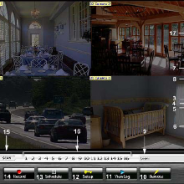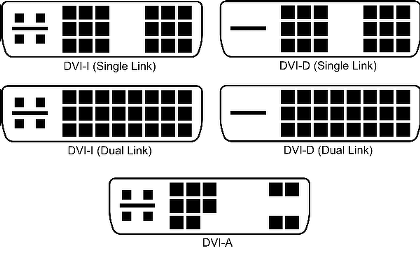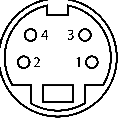Glossary

Aspect Ratio
an expression comparing the width of the screen to the height of the screen. For example, NTSC video normally used for security cameras are the traditional 4:3 (1.33:1) aspect ratio. Widescreen monitors are generally a 16:9 (1.78:1) aspect ratio. The higher the left number relative to the right, the “wider” a screen is relative to the height.For more detailed explanations see the Image Aspect Ratio article on Wikipedia.
Component Video – Named for the method of transmitting the “component” video colors red, green, and blue separately over discrete cables, as opposed to CVBS (composite) video, which transmits luma, chroma, and sync signals over a single signal and cable. The component color signals (RGB, or red, green, and blue) are transmitted separately to preserve detail by reducing interference from crosstalk. Another component video standard (YUV) send the luma (luminescence), chroma (chrominance, or color), and sync signals over separate cables, rather than splitting red, green, and blue color components. Other variants include sending the color info over separate lines, then further separating components by carrying the the horizontal and vertical sync signals on their own lines. For more detailed explanations see the Component Video article on Wikipedia.
VGA is a type of component video connector/cable standard in widespread use in North America. Also, some consider S-video to be a type of component video as luma/sync and chrominance are separated and transmitted separately.


This photograph is an example of a 16:9 (1.78:1) image typical of widescreen video. Note that the photo is relatively wide compared to the height.
Contrast Ratio
A measure of the brightest color to the darkest color that a screen can generate. Most monitor manufacturers specify the contrast ratio using the “static contrast ratio” method, which is a measure of both the brightest and darkest colors the screen can produce at the same given ambient light level in a room. 500:1 is considered a good contrast ratio, 700:1 and 1000:1 are extremely good contrast ratios which have recently become commonplace on higher-end flat-panel LCD monitors. Some manufacturers, to boost their contrast ratio over the competition (to boast bigger numbers in marketing collateral) sometimes quote dynamic contrast ratio (in some cases boosting contrast ratio numbers to 3000:1 or even 5000:1), so when comparing monitors make sure you are comparing apples to apples, and if in doubt, ASK. For additional detailed information information see the contrast ratio article on Wikipedia.
CVBS
(Composite Video Blanking and Sync, or “Composite” for short) – This is an NTSC (or in Europe, PAL or SECAM) video signal which combines the luma (luminescence), sync, and chroma (color) information into one single signal cable. The connector most often used for a composite connection is the “RCA phono” style coax connector. The second most popular connection used with a CVBS signal is a BNC connector (primarily in CCTV and video production environments). For more information see the Composite Video on Wikipedia. A point worth noting is that NTSC video over CVBS is roughly equivalent to standard VGA resolution, although on quality displays the horizontal resolution may slightly higher, resulting in a resolution approximately 720×480.
DVI
(Digital Video Interface) – A video standard which provides a digital video signal which maximizes the video quality of modern digital monitors such as LCD and Plasma flat panel displays. Unlike conventional analog monitors, each pixel (dot) comprising the display is addressed separately, which results in the maximum possible clarity and color accuracy. For detailed information please see the DVI article on Wikipedia.
DVI connectors often provide an analog video signal enabling the use of a conventional analog VGA monitor with the use of a DVI-VGA adapters. Every one of our DVRs is equipped with at least one DVI-I Dual Link video connector, providing compatibility and maximum video quality with a wide range digital monitors while maintaining compatibility with analog monitors.


Dynamic Contrast Ratio
A method of measuring the contrast ratio by which the ambient light levels are adjusted to artificially increase measured numbers. While it is not fraudulent to advertise contrast ratios measured using this method, it is considered by many to be dishonest.
Frame Rate
(frames per second) – the number of images per second displayed on a screen to give the illusion of motion. Television is broadcast at 60 frames per second, and most motion pictures in movie theaters are filmed and displayed at 24 frames per second. For most people 24fps is sufficient to perceive fluid motion without significant flicker.
Television shows, advertisements, and newscasts are typically broadcast at 30 frames per second. Animated shows (cartoons) are often produced for playback at 5 or 7 frames per second for low-budget productions and 12 frames per second or so for better productions. Modern computer-generated animations are usually produced for playback at the full 24 or 30fps (depending on whether it’s intended for broadcast/cable or the theatrical release).
Resolution (Monitors)
Display resolution refers to the number of dots which make up the picture on a screen, usually specified in X x Y (horizontal rows x vertical columns) units. Common display resolutions include 640×480, 1024×768, 1280×960, 1280×1024, and 1920×1200. Note that for the purpose of CCTV we concern ourselves only with display/record resolution, and largely ignore the other aspects of resolution that other industries (such as printers) care about: DPI and LPI.
For a given monitor size, with higher resolution images will appear smaller, because the number of dots comprising the image will be greater, and the individual dots will be smaller. However, higher-resolution monitors are generally clearer/more crisp in appearance.
One term you may find in monitor specifications is “native resolution.” This term refers to ther actual number of rows and columns of pixels a monitor has. LCD monitors can usually display lower than native resolutions, and some high end models can downsample higher than native resolutions, but in both cases some detail is lost. A flat panel monitor (LCD or plasma) always displays the best at its native resolution. Most flat panel manufacturers state the native resolution in their product specifications.
For detailed information on Display Resolution refer to the Display Resolution article on Wikipedia.
For detailed information on Image Resolution and how it relates to DPI and LPI of monitors and print media, please refer to the Wikipedia article on Image Resolution
Resolution (Record and Display)
Resolution is often specified for DVR systems, and there are two often different specifications: record resolution and display resolution. Display resolution is the resolution of the image as displayed on the screen live, not what is played back from a recording. Recording resolution is what is preserved on the hard disk for later viewing. To save disk space and greatly record the recording time capacity, the recording resolution can be decreased. For greater clarity, at the expense of recording time capacity, the recording resolution can be decreased. For comparison purposes, 320×240 resolution is approximately equivalent to a VHS time lapse recorder that has been in use for a while, 640×480 is approximately equivalent to broadcast television, and 704×480 is exactly the same resolution and clarity as a movie DVD (DVDs have 8 blank pixels on either side so if you were to “rip” a DVD frame without stretching the image, it would be a 704×480 or if you stretch it it would be 720×480). Once the footage has been recorded, nothing can be done to increase the recorded detail, so it is wise to be careful when deciding which cameras on which the resolution is decreased for the purpose of saving disk space.
Response Time
A measurement of the time a pixel on an LCD screen takes to transition from black to off to black again, and is usually measured in milliseconds. Lower response times generally results in less blurring for fast-moving images and minimal ghosting. First-generation LCD monitors often exhibited ghosting due to slow response times, resulting in objects such as baseballs taking on a “comet”-like appearance. With nearly all monitor times claiming a response time of 12ms or lower, such artifacts are now rare. Response Time article on Wikipedia.
S-Video
(Separate Video, sometimes referred to as SVHS video, split-video, or super-video in product specs) – This is an NTSC video signal which splits the chroma (color) and luminescence/sync signals into two separate lines, resulting in a Y/C signal. This reduces interference and improves clarity of the NTSC signal by eliminating crosstalk between the Luma and Chroma signals, and at the same time improves color purity. For detailed information see the S-Video article on Wikipedia.
The connector for S-video is typically a min-din plug with four pins, although some S-video devices and jacks include additional pins for audio, and some devices offer either component or CVBS through similar jacks. If using anything other than an S-Video cable to connect to equipment other than S-video, read the documentation carefully as the extra pins are nonstandard and vary from manufacturer to manufacturer. Also, some very old (very late 1970s, early 1980s) equiment implemented S-video using full DIN-size jacks, including early home computers.


VGA
(Video Graphics Array) Strictly speaking VGA does not stand for a plug type, but video standards, but in common use it has come to refer to the 15-pin D-SUB jack commonly found on modern personal computers and more recently on appliance-type digital video recorders. “VGA-Compatible” monitors are readily available. See VGA Connector. See the Wikipedia article on VGA for history and more information on the VGA standard.
VGA Connector:
a 15-pin D-SUB connector consisting of three alternately offset rows of five pins each which is used for transmittiong analog component video signals, usually adhering to various VESA-defined VGA standards. Standard VGA modes may consist of any of the following:
- 640×480, 16 colors
- 640×350, 16 colors
- 320×200, 16 colors
- 320×200, 256 colors
But in common use VGA has come to refer to any 640×480 resolution display mode, including “high color” 15-and-16-bit and “true color” 24/32-bit color modes. In CCTV use, VGA almost universally refers to true color at 640×480.
VGA uses a type of component video signal but over a single connector. In fact there are VGA -> component BNC cables available for using VGA devices with R/G/B or YUV monitors.




 sending...
sending...